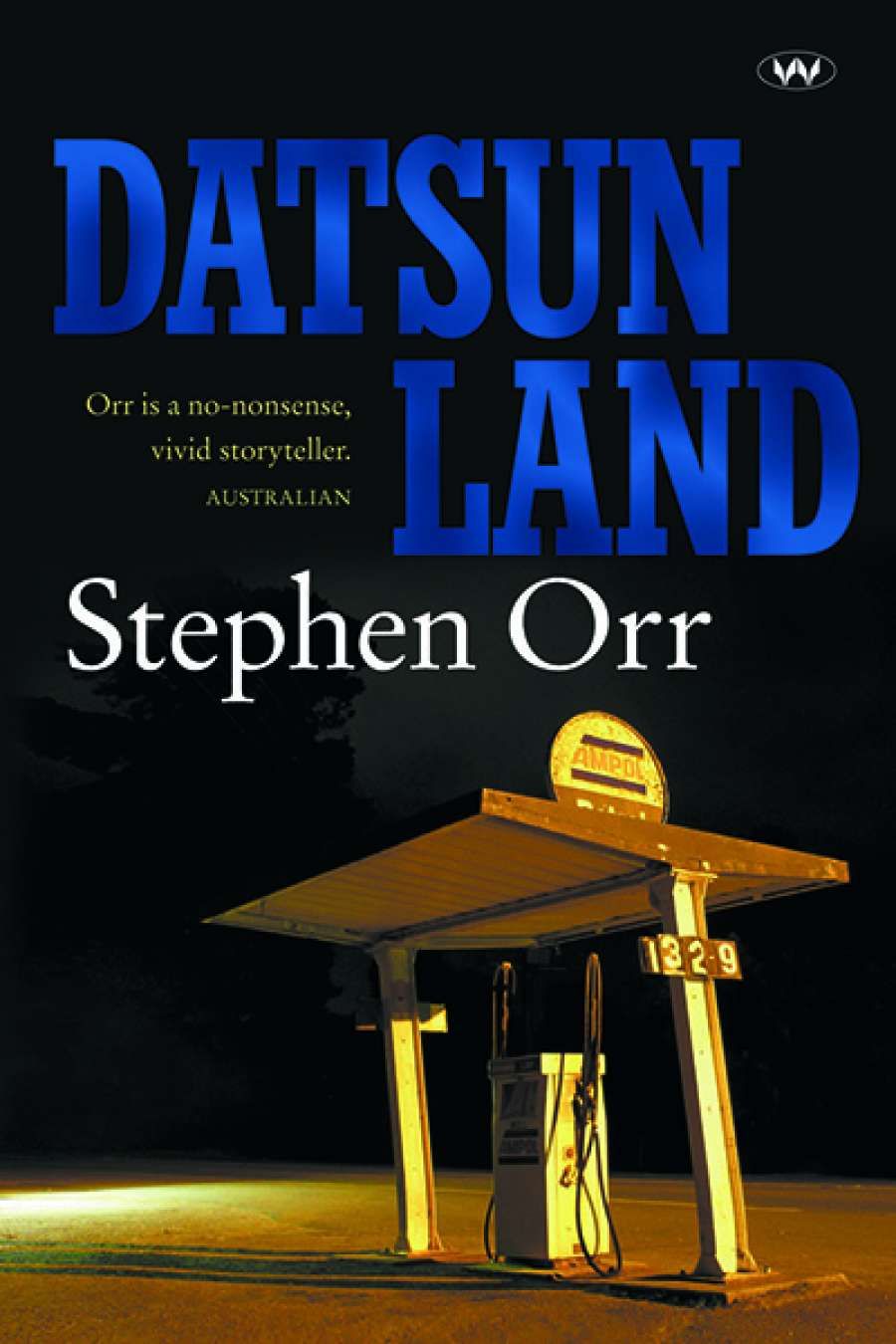
- Free Article: No
- Contents Category: Fiction
- Custom Article Title: Catherine Noske reviews 'Datsunland' by Stephen Orr
- Review Article: Yes
- Online Only: No
- Book 1 Title: Datsunland
- Book 1 Biblio: Wakefield Press $29.95 pb, 312 pp, 9781743054758
It might be this which makes the collection compelling. There is a modernist sensibility to the continued fluctuations in the narrative perspective, furthered by intertextual allusions within the text and an emphasis on the experience of consciousness in the writing style. Moments in almost every story border on interior monologue, and descriptions regularly use parataxis to push at the boundaries of linguistic representation. This aspect of the writing allows for an exploration of masculinity in the Australian setting, and opens a range of related narratives relevant to contemporary society, from the racial tensions the opening story, ‘Dr Singh’s Despair’, to the simmering violence of domestic abuse, which permeates the collection as a whole and comes to a head with the murder of a six-year-old in ‘The Adult World Opera’. The final story, ‘Datsunland’, is a beautiful example of this. Shifting constantly across the perspectives of schoolboy Charlie, his father Damien, and his guitar teacher William, it combines the experiences of all three. The movement between characters is often unexpected, undermining and layering different experiences and assumptions to destabilise the reader’s engagement with each. The effect as a whole is to feel in the story an anxiety in the mundanity of life, and an insistence on questioning moments of purpose and fulfilment, even while allowing for the simplicity and beauty of such moments.
That said, certain weaknesses in the collection as a whole do at times inhibit its reading. There are stories which are too recognisable, such as the IRA shooting of a busload of Protestant workers in ‘The Confirmation’, a reimagining of the Kingsmill massacre. But more disruptive is the sense that several of the characters invoked are stock types, made familiar by the Gothic overtones of several narratives, a literary context invoked likewise in the book’s design. In ‘The Syphilis Museum’, for instance, grandmother Flora sets fire to a museum and murders its ultra-religious caretaker in revenge for the failure of that man’s father to offer her mother contraceptives and thus prevent her (and her children’s) suffering from the syphilis her husband brought home with him. The (somewhat confusing) interweaving of the small-town minds and relationships meets in the piece with an interrogation of morality within the Catholic faith, a common theme explored in several works. But it relies on somewhat caricatured protagonists to carry the narrative, limiting the possibilities of engaging with the more interesting conceptualisation of faith that lies beneath.
 Stephen Orr (photograph by Philip Martin)Similarly, women in the collection are either absent or unconvincing. Of the fourteen stories, eleven focus directly on the experiences of men, and the remaining three seat their female protagonists beside a (dominant) male focalisation. Orr’s women are contained and constrained by men, offered limited perspectives, and rarely provided with any agency in the narrative structure. In ‘The Shot-put’, Barb’s mourning for her lost son is subsumed by Sam’s depression and her solicitude for her husband; in ‘A Descriptive List of the Birds Native to Shearwater, Australia’, Susan’s growing disenchantment with her new husband gives way to his growing consciousness of the associations of bullying and family violence which subconsciously drive his behaviour; and in ‘The Syphilis Museum’, Flora’s role in the narrative enters only as the climax of the story, and despite some moments of focalisation, sees her act as antagonist rather than fully developed protagonist. That this is a work which seemingly intends (and succeeds in) considering Australian masculinities doesn’t quite excuse the transparency of the female characters as portrayed.
Stephen Orr (photograph by Philip Martin)Similarly, women in the collection are either absent or unconvincing. Of the fourteen stories, eleven focus directly on the experiences of men, and the remaining three seat their female protagonists beside a (dominant) male focalisation. Orr’s women are contained and constrained by men, offered limited perspectives, and rarely provided with any agency in the narrative structure. In ‘The Shot-put’, Barb’s mourning for her lost son is subsumed by Sam’s depression and her solicitude for her husband; in ‘A Descriptive List of the Birds Native to Shearwater, Australia’, Susan’s growing disenchantment with her new husband gives way to his growing consciousness of the associations of bullying and family violence which subconsciously drive his behaviour; and in ‘The Syphilis Museum’, Flora’s role in the narrative enters only as the climax of the story, and despite some moments of focalisation, sees her act as antagonist rather than fully developed protagonist. That this is a work which seemingly intends (and succeeds in) considering Australian masculinities doesn’t quite excuse the transparency of the female characters as portrayed.
Overall, however, the collection is powerful, driven by the viscerality of Orr’s writing. The depiction of violence, emotional and social as well as physical, leaves an impression. This is writing which can shock, which does not hesitate in portraying extremes, but which at the same time holds the capacity for simplicity and tenderness. There is an eeriness in the reading as a result. Orr’s work here left me sensitive to the instability of Australian ground.


Comments powered by CComment